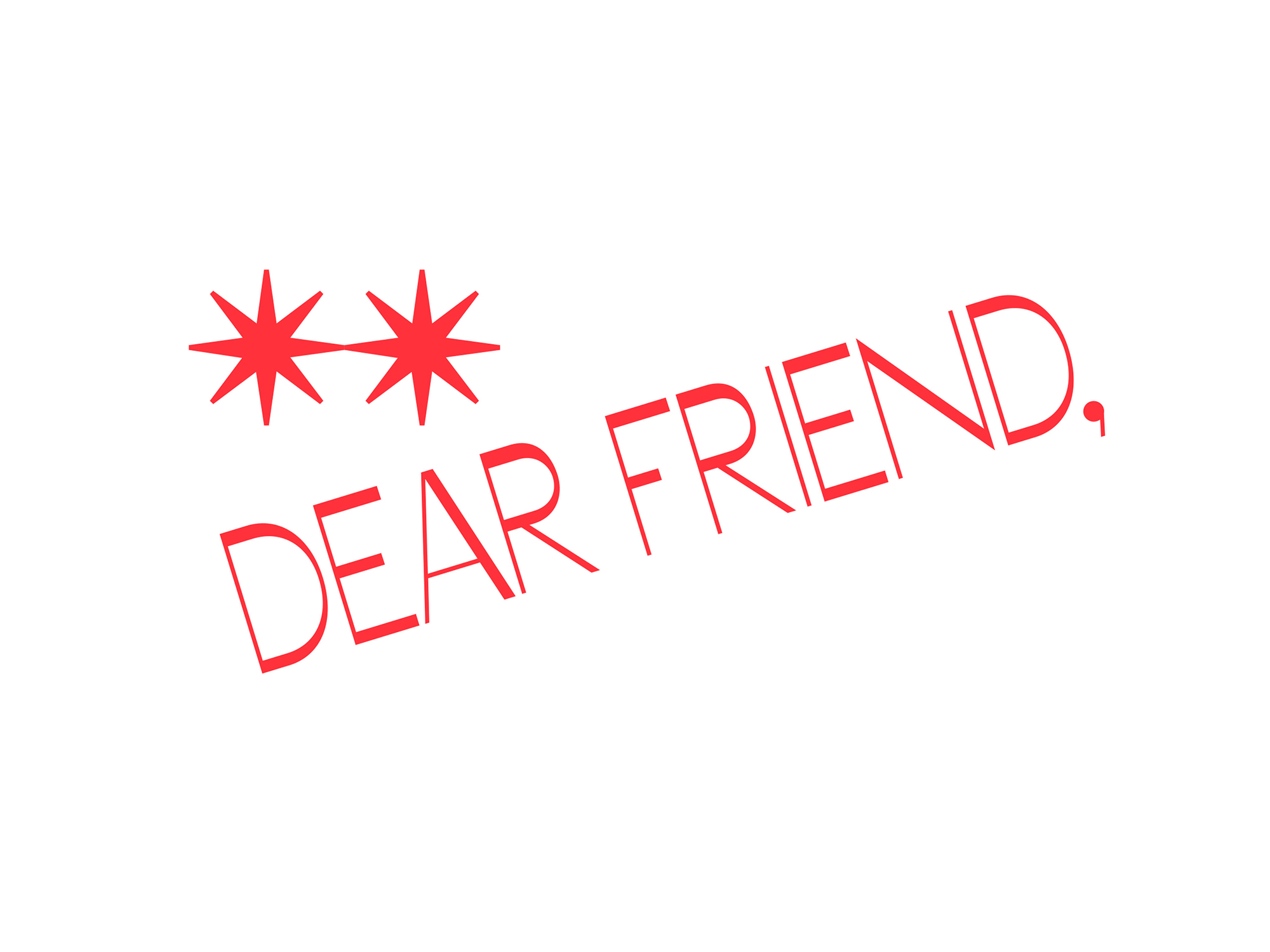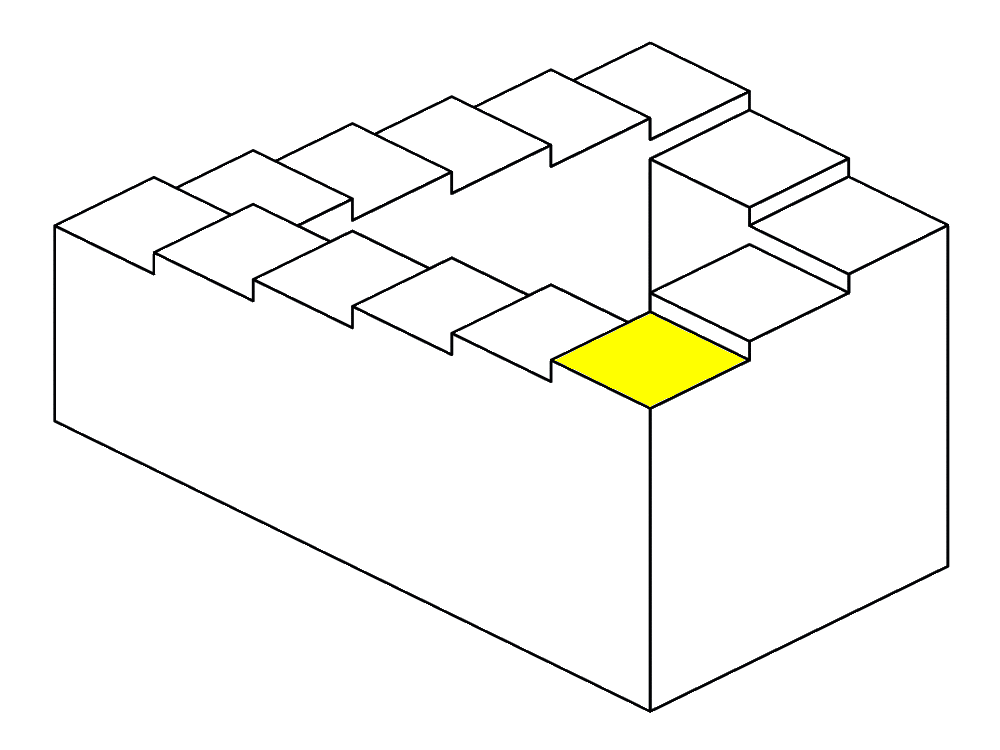Dear Friend
2021
This short text was a request from Sandra Nuut and Ott Kagovere from the Estonian Academy of Arts in Tallin to contribute to a series of design-related “letters to a friend” that in some way reflected on COVID-19 lockdown life at the time. The individual epistles were physically mailed out to a growing circle of friends, and collected into a book of the same name in 2022.
*

Dear Friend,
Shortly after the first lockdown began some fifteen months or so ago, the Institute of Contemporary Arts in London where I work began releasing an “ICA Daily” email—being a scattershot list of online viewing, reading and listening compiled at speed by our curators and promptly dispatched at 10am every morning, including weekends.
When I first overhauled the ICA’s graphic identity back in 2017, one ingredient of the DNA was a set of “classic” optical illusions, such as the well-known Duck-Rabbit, Impossible Triangle, or Reversible Stairs. The idea was to put these images to work as visual headers for categories that didn't otherwise have any obvious title or unifying theme. Many of these illusions have an “either/or” aspect, in the sense that the Duck-Rabbit is both duck and rabbit. They are fundamentally difficult to pin down and, as such, usefully ambiguous—as optical allusions. They also have the benefit of being free-floating, freely signifying icons that don't really belong to anyone, surely doing the rounds in the public domain long before intellectual property or copyright laws were dreamed up.
As time went on, we started to use the illusions more broadly to represent—or avoid representing—various bits and pieces of the Institute. I keep a folder of unused examples on my desktop waiting to be summoned for use, and, when the idea of the daily email came up, the illusion of Eternal Stairs most famously depitcted in M.C. Escher’s 1960 lithograph “Ascending and Descending” seemed perfectly suited: a series of quotidian steps of unknown duration or destination, operating outside any regular sense of time and space. To emphasise the ennui, I animated the staircase by highlighting each subsequent step with a yellow panel, plodding round and round and round and round.
With this image in mind, and against my better instincts, I thought I’d take this opportunity to highlight another couple of Lockdown Projects that caught my attention. I say “against my better instincts” because I consider myself the opposite of a lockdown project sort of person—and in fact I only happened across the first one thanks to the headline “I Don't Want to See Your Quarantine ‘Art’ Unless It's This.”
It was an attempt by members of two London-based bands, Fat White Family and Pregoblin, to re-enact the entirety of the 1994 “cult mainstream” film The Shawshank Redemption scene by scene on Instagram Stories. What appealed to me above all was how the two groups' vocalists, Lias Saoudi and Alex Sebley—who respectively play the Morgan Freeman and Tim Robbins roles—seemed to be taking such a ridiculous idea so seriously, or at least were attempting to do it with some degree of rigour and commitment, whatever that might have meant at the beginning of the first wave of the pandemic.
Naturally, it all takes place within the confines of what is presumably one of their houses, starting out in a shabby garden (prison yard), then moving into a sparsely populated lounge (prison cell) while swigging freely from cans of beer (cups of water). The only piece of the fictional fourth wall left remotely intact, in fact, is their risky yet plausible attempt to mimic the two characters’ American accents.
I’ve long forgotten the source of a phrase I once read or heard that describes good design work as “carrying the right weight”—which I take to mean an equilibrium between form and content, or vehicle and material. And in the case of this Insta-Shawshank, there’s something about the bare bones of an epic Hollywood script being squeezed through the severely restrictive possibilities of a social media channel within our newly claustrophobic COVID world that carries the right weight for me. Or maybe it’s just the dumb idea of a prison film being made from the prison of lockdown that seems oddly liberating. To my considerable disappointment, they only made it as far as three scenes before apparently giving up.
My other highlight also takes the form of an incremental series, though this one is still ongoing at the time of writing. Richard Dawson is a beloved, difficult-to-summarize musician from Newcastle who released a masterpiece single of very English social realism called “Jogging” in 2019, soon followed by the album 2020 just months before the year in question became a write-off.
On the very first day of the first UK lockdown, Monday March 23, Dawson and his bandmate/partner Sally Pilkington quietly issued a 10-minute piece of hypnotic, lo-fi ambient music via Bandcamp under the name Bulbils, and continued to release an extended piece or suite of similar music on a daily basis. The individual tracks are mostly named by a single word (“Funnel,” “Mole,” “Oxygen”) then collected under a similarly blank or deadpan umbrella title (“Donkey,” “Mounds,” “Spring”), gradually becoming more suggestive (“Child's Dreaming of a Storm,” “The Palace at Day and Night,” “Journey of the Canada Goose”) and even vaguely topical (“Conspiracy Faeries,” “Tax Return,” “Vaccine”) as the weeks and months roll on.
There's a resounding graphic design note to the project too, as each release comes with its own little square of artwork based on a simple template: 1. a suggestible image, as loosely related to the title as the titles are to the music, and 2. the word “Bulbils” set in some strangely specific font in the top left corner.
Writing this now, I realize that what I really love about the project is precisely how slippery the whole thing is. The music + the title + the image + the typeface almost amount to a meaningful whole. But not quite. At times Bulbils feels like a joke or pastiche, at others like a form of therapy or coping mechanism. And like those optical illusions, it doesn't have to be one thing or the other. It can also be neither or both or all of the above.
In these two projects—one outlandish, one meditative—I can dimly perceive an alignment of the form and content of the pandemic itself that have irregularly nourished me while regular culture has been on hold.
•

